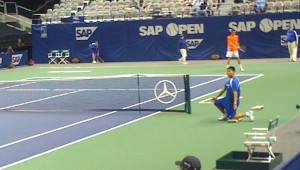KNOWING WHERE THE BALL SHOULD BOUNCE - MORE ON TEAM SITUATIONAL AWARENESS
/
The SAP Open men’s tennis tournament is on this week in San Jose. While watching some of the early round play it occurred to me that team situational awareness is not only found in world-class doubles teams like the Bryan Brothers (who clearly have a form of ESP that takes this to a whole new level), but is also apparent elsewhere on the court.
The ball kids did a great job of providing the information necessary to enable inputs (balls) to be with the right people at the right time, managing external requirements (feeding the balls to the players when requested), anticipating performance needs (stationing themselves appropriately on the court), and managing interruptions (not running into each other). In the picture below you can see the ballkid showing empty hands, meaning, “I don’t have any balls to give you.” This signal is given to the teammates on both sides.
I’m generally not a fan of field trips as part of team training (studies of transactive memory – another key dimension of team success -- suggest that team training should focus on the task the team is actually going to do), but if it means a free ticket to the tennis, maybe I’ll change my mind. Watching ballkids in action provides a great opportunity to use another team’s performance to assess your own. How much effort went into thinking out the team’s task, the staffing, the training, how team members will communicate with each other, incentives, etc. The ballkid team is especially explicit with this process given they are short-term volunteers who may have no experience.
What signals (either social or technical) do your teams use to keep the rest of the team apprised of the situation? Yes, team members can use implicit processes (e.g., tracking workflows, seeing the number of replies on an email) to try and make sense of the situation. But sometimes we need to do more. The ballkids have the benefit of being engaged for a relatively short time – they rotate so attention stays high – and they are working face to face on a single team. We can use “open mic” strategies (see comment to earlier post), but that may only work when team members are focused on a single project. I hope to have some more ideas soon, but would appreciate hearing from your experiences, especially when you're on multiple teams.
The ball kids did a great job of providing the information necessary to enable inputs (balls) to be with the right people at the right time, managing external requirements (feeding the balls to the players when requested), anticipating performance needs (stationing themselves appropriately on the court), and managing interruptions (not running into each other). In the picture below you can see the ballkid showing empty hands, meaning, “I don’t have any balls to give you.” This signal is given to the teammates on both sides.

I’m generally not a fan of field trips as part of team training (studies of transactive memory – another key dimension of team success -- suggest that team training should focus on the task the team is actually going to do), but if it means a free ticket to the tennis, maybe I’ll change my mind. Watching ballkids in action provides a great opportunity to use another team’s performance to assess your own. How much effort went into thinking out the team’s task, the staffing, the training, how team members will communicate with each other, incentives, etc. The ballkid team is especially explicit with this process given they are short-term volunteers who may have no experience.
What signals (either social or technical) do your teams use to keep the rest of the team apprised of the situation? Yes, team members can use implicit processes (e.g., tracking workflows, seeing the number of replies on an email) to try and make sense of the situation. But sometimes we need to do more. The ballkids have the benefit of being engaged for a relatively short time – they rotate so attention stays high – and they are working face to face on a single team. We can use “open mic” strategies (see comment to earlier post), but that may only work when team members are focused on a single project. I hope to have some more ideas soon, but would appreciate hearing from your experiences, especially when you're on multiple teams.







